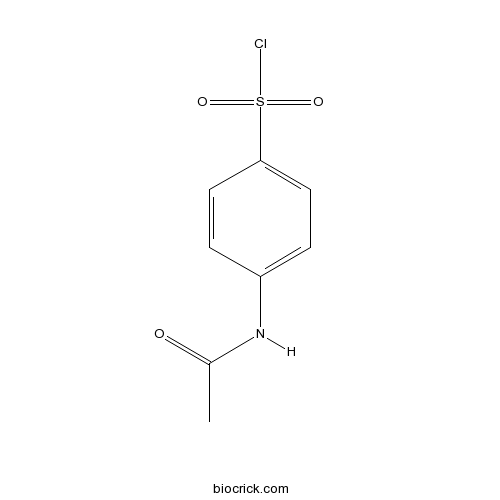N-Acetylsulfanilyl chlorideCAS# 121-60-8 |

Quality Control & MSDS
3D structure
Package In Stock
Number of papers citing our products

| Cas No. | 121-60-8 | SDF | Download SDF |
| PubChem ID | 8481 | Appearance | Powder |
| Formula | C8H8ClNO3S | M.Wt | 233.7 |
| Type of Compound | N/A | Storage | Desiccate at -20°C |
| Solubility | Soluble in Chloroform,Dichloromethane,Ethyl Acetate,DMSO,Acetone,etc. | ||
| Chemical Name | 4-acetamidobenzenesulfonyl chloride | ||
| SMILES | CC(=O)NC1=CC=C(C=C1)S(=O)(=O)Cl | ||
| Standard InChIKey | GRDXCFKBQWDAJH-UHFFFAOYSA-N | ||
| Standard InChI | InChI=1S/C8H8ClNO3S/c1-6(11)10-7-2-4-8(5-3-7)14(9,12)13/h2-5H,1H3,(H,10,11) | ||
| General tips | For obtaining a higher solubility , please warm the tube at 37 ℃ and shake it in the ultrasonic bath for a while.Stock solution can be stored below -20℃ for several months. We recommend that you prepare and use the solution on the same day. However, if the test schedule requires, the stock solutions can be prepared in advance, and the stock solution must be sealed and stored below -20℃. In general, the stock solution can be kept for several months. Before use, we recommend that you leave the vial at room temperature for at least an hour before opening it. |
||
| About Packaging | 1. The packaging of the product may be reversed during transportation, cause the high purity compounds to adhere to the neck or cap of the vial.Take the vail out of its packaging and shake gently until the compounds fall to the bottom of the vial. 2. For liquid products, please centrifuge at 500xg to gather the liquid to the bottom of the vial. 3. Try to avoid loss or contamination during the experiment. |
||
| Shipping Condition | Packaging according to customer requirements(5mg, 10mg, 20mg and more). Ship via FedEx, DHL, UPS, EMS or other couriers with RT, or blue ice upon request. | ||

N-Acetylsulfanilyl chloride Dilution Calculator

N-Acetylsulfanilyl chloride Molarity Calculator
| 1 mg | 5 mg | 10 mg | 20 mg | 25 mg | |
| 1 mM | 4.279 mL | 21.395 mL | 42.7899 mL | 85.5798 mL | 106.9748 mL |
| 5 mM | 0.8558 mL | 4.279 mL | 8.558 mL | 17.116 mL | 21.395 mL |
| 10 mM | 0.4279 mL | 2.1395 mL | 4.279 mL | 8.558 mL | 10.6975 mL |
| 50 mM | 0.0856 mL | 0.4279 mL | 0.8558 mL | 1.7116 mL | 2.1395 mL |
| 100 mM | 0.0428 mL | 0.2139 mL | 0.4279 mL | 0.8558 mL | 1.0697 mL |
| * Note: If you are in the process of experiment, it's necessary to make the dilution ratios of the samples. The dilution data above is only for reference. Normally, it's can get a better solubility within lower of Concentrations. | |||||

Calcutta University

University of Minnesota

University of Maryland School of Medicine

University of Illinois at Chicago

The Ohio State University

University of Zurich

Harvard University

Colorado State University

Auburn University

Yale University

Worcester Polytechnic Institute

Washington State University

Stanford University

University of Leipzig

Universidade da Beira Interior

The Institute of Cancer Research

Heidelberg University

University of Amsterdam

University of Auckland

TsingHua University

The University of Michigan

Miami University

DRURY University

Jilin University

Fudan University

Wuhan University

Sun Yat-sen University

Universite de Paris

Deemed University

Auckland University

The University of Tokyo

Korea University
- Benzethonium Chloride
Catalog No.:BCC4635
CAS No.:121-54-0
- (-)-Terreic acid
Catalog No.:BCC7051
CAS No.:121-40-4
- Vanillic acid
Catalog No.:BCN6105
CAS No.:121-34-6
- Vanillin
Catalog No.:BCN2605
CAS No.:121-33-5
- 3-Deazaneplanocin A (DZNep) hydrochloride
Catalog No.:BCC3604
CAS No.:120964-45-6
- FPL 64176
Catalog No.:BCC7050
CAS No.:120934-96-5
- Isoliquiritin apioside
Catalog No.:BCN2914
CAS No.:120926-46-7
- PF-03394197(Oclacitinib)
Catalog No.:BCC6474
CAS No.:1208319-26-9
- N6022
Catalog No.:BCC4127
CAS No.:1208315-24-5
- Ketone Ester
Catalog No.:BCC1677
CAS No.:1208313-97-6
- VU 0365114
Catalog No.:BCC6164
CAS No.:1208222-39-2
- CaMKII-IN-1
Catalog No.:BCC5530
CAS No.:1208123-85-6
- 2-Amino-5-nitrothiazole
Catalog No.:BCC8538
CAS No.:121-66-4
- Propyl gallate
Catalog No.:BCN8431
CAS No.:121-79-9
- 3'-Nitroacetophenone
Catalog No.:BCN2256
CAS No.:121-89-1
- ST 1936 oxalate
Catalog No.:BCC7919
CAS No.:1210-81-7
- N-Acetyl-5-Hydroxytryptamine
Catalog No.:BCC9080
CAS No.:1210-83-9
- JZL 195
Catalog No.:BCC7966
CAS No.:1210004-12-8
- Secretin (rat)
Catalog No.:BCC5848
CAS No.:121028-49-7
- Nelarabine
Catalog No.:BCC1072
CAS No.:121032-29-9
- IEM 1460
Catalog No.:BCC7135
CAS No.:121034-89-7
- PF-04971729
Catalog No.:BCC1852
CAS No.:1210344-57-2
- Abiesadine I
Catalog No.:BCN6104
CAS No.:1210347-50-4
- Melanotan II
Catalog No.:BCC7414
CAS No.:121062-08-6
Synthesis of hapten and production of a monoclonal antibody against a derivative of L-hydroxyproline, a special amino acid in hydrolyzed animal protein.[Pubmed:23030435]
J Environ Sci Health B. 2013;48(1):9-15.
China's government has prohibited the addition of simply hydrolyzed animal protein from solid leather waste into milk. The objective of this study was to produce a monoclonal antibody against L-hydroxyproline, a special amino acid in hydrolyzed animal protein. L-hydroxyproline was derivatized with N-Acetylsulfanilyl chloride and 5-chlorovaleric acid to synthesize the haptens HP1 and HP2. Then, two immunogens from the two haptens were prepared to produce the antibodies. Results showed that only HP1 was able to stimulate the animal immune system and generate the specific antibody to L-hydroxyproline (as the formation of HP1). The obtained monoclonal antibody from HP1 and the heterologous coating hapten HP2 were incorporated into a competitive indirect enzyme linked immunosorbent assay (ELISA) to determine the antibody's specificity and sensitivity. The IC(50) and the limit of detection for HP1 were 0.16 mug/mL and 0.05 mug/mL respectively. The antibody showed low crossreactivity to parental L-hydroxyproline and showed negligible crossreactivity to D-hydroxyproline and other amino acids. The monoclonal antibody was therefore suitable for the development of an immunoassay to monitor the simply hydrolyzed animal protein from solid leather waste in foodstuffs with L-hydroxyproline as the target analyte.


